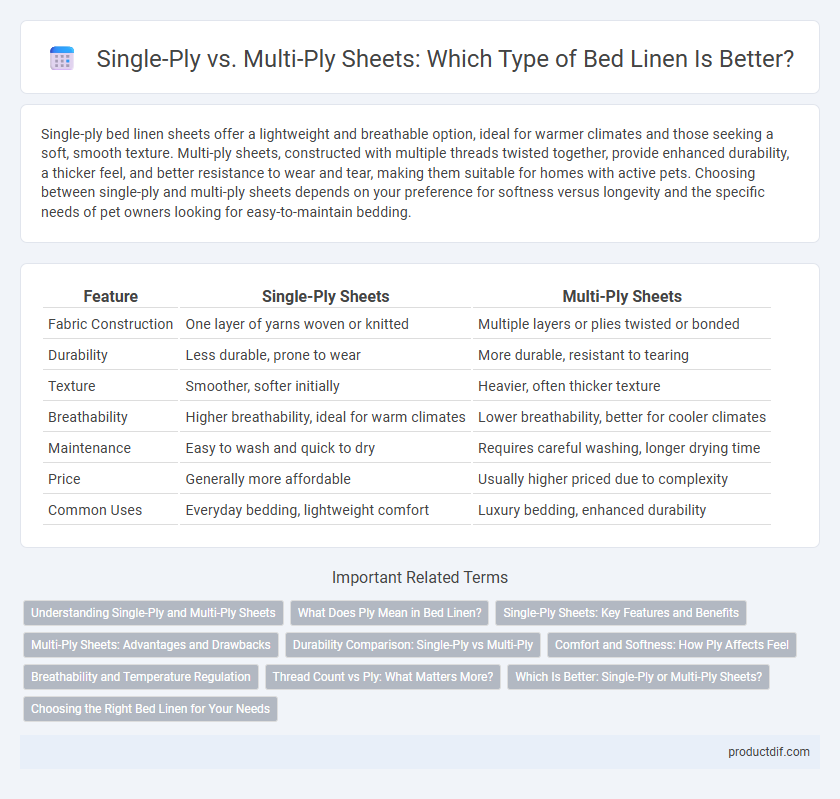Single-ply bed linen sheets offer a lightweight and breathable option, ideal for warmer climates and those seeking a soft, smooth texture. Multi-ply sheets, constructed with multiple threads twisted together, provide enhanced durability, a thicker feel, and better resistance to wear and tear, making them suitable for homes with active pets. Choosing between single-ply and multi-ply sheets depends on your preference for softness versus longevity and the specific needs of pet owners looking for easy-to-maintain bedding.
Table of Comparison
| Feature | Single-Ply Sheets | Multi-Ply Sheets |
|---|---|---|
| Fabric Construction | One layer of yarns woven or knitted | Multiple layers or plies twisted or bonded |
| Durability | Less durable, prone to wear | More durable, resistant to tearing |
| Texture | Smoother, softer initially | Heavier, often thicker texture |
| Breathability | Higher breathability, ideal for warm climates | Lower breathability, better for cooler climates |
| Maintenance | Easy to wash and quick to dry | Requires careful washing, longer drying time |
| Price | Generally more affordable | Usually higher priced due to complexity |
| Common Uses | Everyday bedding, lightweight comfort | Luxury bedding, enhanced durability |
Understanding Single-Ply and Multi-Ply Sheets
Single-ply sheets consist of a single, continuous thread woven tightly to create a smooth and lightweight fabric that offers breathability and a sleek feel. Multi-ply sheets are made from multiple threads twisted together before weaving, resulting in greater durability, a heavier texture, and enhanced softness over time. Understanding the difference helps consumers choose bed linen based on preferences for texture, longevity, and comfort.
What Does Ply Mean in Bed Linen?
Ply in bed linen refers to the number of yarn strands twisted together to create the fabric, impacting durability and texture. Single-ply sheets are made from one continuous strand of yarn, resulting in a softer and more breathable fabric. Multi-ply sheets combine two or more strands, offering increased strength and a slightly heavier feel.
Single-Ply Sheets: Key Features and Benefits
Single-ply sheets are crafted from a single layer of yarn, delivering a smoother, softer texture and superior breathability compared to multi-ply sheets. Their lightweight construction enhances airflow, making them ideal for hot sleepers and warm climates. The durability of single-ply fabrics resists pilling and maintains fabric integrity after repeated washes, providing long-lasting comfort and quality.
Multi-Ply Sheets: Advantages and Drawbacks
Multi-ply sheets, made from multiple yarns twisted together, offer enhanced durability and a luxurious feel compared to single-ply sheets. They provide improved tear resistance and a smoother texture, making them ideal for long-term use and premium bedding collections. However, multi-ply sheets tend to be heavier and more expensive, and they may require more care to maintain their softness over time.
Durability Comparison: Single-Ply vs Multi-Ply
Single-ply sheets consist of one layer of fabric, resulting in a thinner weave that balances softness with moderate durability. Multi-ply sheets are woven from multiple layers of yarns twisted together, creating a thicker, stronger fabric that resists wear and tearing over time. The enhanced tensile strength and increased thread density of multi-ply sheets make them more durable and longer-lasting compared to single-ply options.
Comfort and Softness: How Ply Affects Feel
Single-ply sheets offer a smooth, lightweight texture that enhances breathability and softness, ideal for those who prefer a delicate feel against the skin. Multi-ply sheets, made by weaving or bonding multiple yarn strands, provide greater durability and a plush, cushioned texture that improves overall comfort. The increased thickness in multi-ply sheets often results in a more substantial, luxurious feel, while single-ply sheets excel in moisture-wicking and temperature regulation.
Breathability and Temperature Regulation
Single-ply sheets, made from a single layer of yarn, offer superior breathability and better temperature regulation by allowing more airflow and moisture wicking, which helps keep the sleeper cool and dry. Multi-ply sheets consist of multiple twisted yarns, creating a denser fabric that can trap heat and reduce ventilation, making them less ideal for those prone to overheating during sleep. Choosing single-ply bed linens enhances comfort in warm climates by promoting a cooler and more breathable sleeping environment.
Thread Count vs Ply: What Matters More?
Thread count measures the number of threads per square inch, while ply refers to the number of fibers twisted together to make a single thread; multi-ply sheets typically offer enhanced durability and softness compared to single-ply. High thread count with single-ply can sometimes be misleading due to thread thickness, making multi-ply a more reliable indicator of quality. Prioritizing multi-ply sheets with moderate to high thread counts ensures a balanced combination of strength, comfort, and longevity in bed linen.
Which Is Better: Single-Ply or Multi-Ply Sheets?
Single-ply sheets are made from a single layer of yarn, offering a lighter, more breathable fabric ideal for warm climates or those who prefer a soft, smooth feel. Multi-ply sheets consist of multiple yarn strands twisted together, resulting in a stronger, more durable fabric with increased thickness and longevity. Choosing between single-ply and multi-ply sheets depends on your preferences for softness versus durability, with single-ply providing better breathability and multi-ply ensuring enhanced robustness and a heavier feel.
Choosing the Right Bed Linen for Your Needs
Single-ply bed linen offers a lightweight and breathable option, ideal for warm climates and those who prefer a softer, smoother feel against the skin. Multi-ply sheets provide enhanced durability and a thicker texture, making them suitable for cooler environments and users seeking long-lasting quality. Selecting between single-ply and multi-ply depends on personal comfort preferences, climate conditions, and the desired balance between softness and resilience in bed linen.
Single-Ply vs Multi-Ply Sheets Infographic

 productdif.com
productdif.com